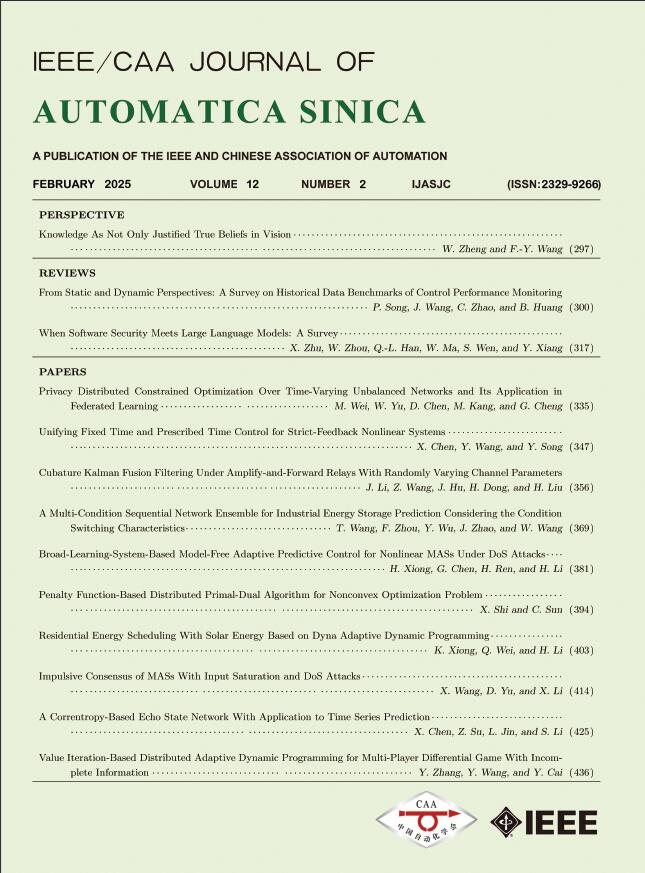 Volume 12
Issue 2
Volume 12
Issue 2
IEEE/CAA Journal of Automatica Sinica
| Citation: | P. Tang and X. Luo, “Neural Tucker factorization,” IEEE/CAA J. Autom. Sinica, vol. 12, no. 2, pp. 475–477, Feb. 2025. doi: 10.1109/JAS.2024.124977 |

| [1] |
N. Zeng, X. Li, P. Wu, H. Li, and X. Luo, “A novel tensor decomposition-based efficient detector for low-altitude aerial objects with knowledge distillation scheme,” IEEE/CAA J. Autom. Sinica, vol. 11, no. 2, pp. 487–501, 2024. doi: 10.1109/JAS.2023.124029
|
| [2] |
W. Luan, G. Liu, C. Jiang, and L. Qi, “Partition-based collaborative tensor factorization for POI recommendation,” IEEE/CAA J. Autom. Sinica, vol. 4, no. 3, pp. 437–446, 2017. doi: 10.1109/JAS.2017.7510538
|
| [3] |
P. Wu, H. Li, L. Hu, J. Ge, and N. Zeng, “A local-global attention fusion framework with tensor decomposition for medical diagnosis,” IEEE/CAA J. Autom. Sinica, vol. 11, no. 6, pp. 1536–1538, 2024. doi: 10.1109/JAS.2023.124167
|
| [4] |
H. Wu, X. Luo, M. Zhou, M. J. Rawa, K. Sedraoui, and A. Albeshri, “A PID-incorporated latent factorization of tensors approach to dynamically weighted directed network analysis,” IEEE/CAA J. Autom. Sinica, vol. 9, no. 3, pp. 533–546, 2022. doi: 10.1109/JAS.2021.1004308
|
| [5] |
F. Bi, X. Luo, B. Shen, H. Dong, and Z. Wang, “Proximal alternating-direction-method-of-multipliers-incorporated nonnegative latent factor analysis,” IEEE/CAA J. Autom. Sinica, vol. 10, no. 6, pp. 1388–1406, 2023. doi: 10.1109/JAS.2023.123474
|
| [6] |
X. Luo, H. Wu, Z. Wang, J. Wang, and D. Meng, “A novel approach to large-scale dynamically weighted directed network representation,” IEEE Trans. Pattern Anal. Mach. Intell., vol. 44, no. 12, pp. 9756–9773, 2022. doi: 10.1109/TPAMI.2021.3132503
|
| [7] |
X. Luo, M. Zhou, Y. Xia, and Q. Zhu, “An efficient non-negative matrix-factorization-based approach to collaborative filtering for recommender systems,” IEEE Trans. Ind. Inform., vol. 10, no. 2, pp. 1273–1284, 2014. doi: 10.1109/TII.2014.2308433
|
| [8] |
X. Luo, M. Zhou, Z. Wang, Y. Xia, and Q. Zhu, “An effective scheme for QoS estimation via alternating direction method-based matrix factorization,” IEEE Trans. Serv. Comput., vol. 12, no. 4, pp. 503–518, 2019. doi: 10.1109/TSC.2016.2597829
|
| [9] |
S. Wang, Y. Ma, B. Cheng, F. Yang, and R. N. Chang, “Multi-dimensional QoS prediction for service recommendations,” IEEE Trans. Serv. Comput., vol. 12, no. 1, pp. 47–57, 2019.
|
| [10] |
X. Luo, Z. Liu, S. Li, M. Shang, and Z. Wang, “A fast non-negative latent factor model based on generalized momentum method,” IEEE Trans. Syst., Man, Cybern.: Syst., vol. 51, no. 1, pp. 610–620, 2021. doi: 10.1109/TSMC.2018.2875452
|
| [11] |
W. Zhang, H. Sun, X. Liu, and X. Guo, “Temporal QoS-aware web service recommendation via non-negative tensor factorization,” in Proc. 23rd Int. Conf. World Wide Web, 2014, pp. 585–596.
|
| [12] |
X. Luo, H. Wu, H. Yuan, and M. Zhou, “Temporal pattern-aware QoS prediction via biased non-negative latent factorization of tensors,” IEEE Trans. Cybern., vol. 50, no. 5, pp. 1798–1809, 2020. doi: 10.1109/TCYB.2019.2903736
|
| [13] |
F. Ye, Z. Lin, C. Chen, Z. Zheng, and H. Huang, “Outlier-resilient web service QoS prediction.” in Proc. Web Conf., 2021, pp. 3099–3110.
|
| [14] |
X. He, L. Liao, H. Zhang, L. Nie, X. Hu, and T.-S. Chua, “Neural collaborative filtering,” in Proc. 26th Int. Conf. World Wide Web, 2017, pp. 173–182.
|
| [15] |
P. Tang, T. Ruan, H. Wu, and X. Luo, “Temporal pattern-aware QoS prediction by biased non-negative Tucker factorization of tensors,” Neurocomputing, vol. 582, p. 127447, 2024. doi: 10.1016/j.neucom.2024.127447
|
| [16] |
T. G. Kolda and B. W. Bader, “Tensor decompositions and applications,” SIAM Rev., vol. 51, no. 3, pp. 455–500, 2009. doi: 10.1137/07070111X
|
| [17] |
A. Mnih and R. R. Salakhutdinov, “Probabilistic matrix factorization,” in Proc. Advances in Neural Infor. Proc. Syst., 2007, pp. 1257–1264.
|